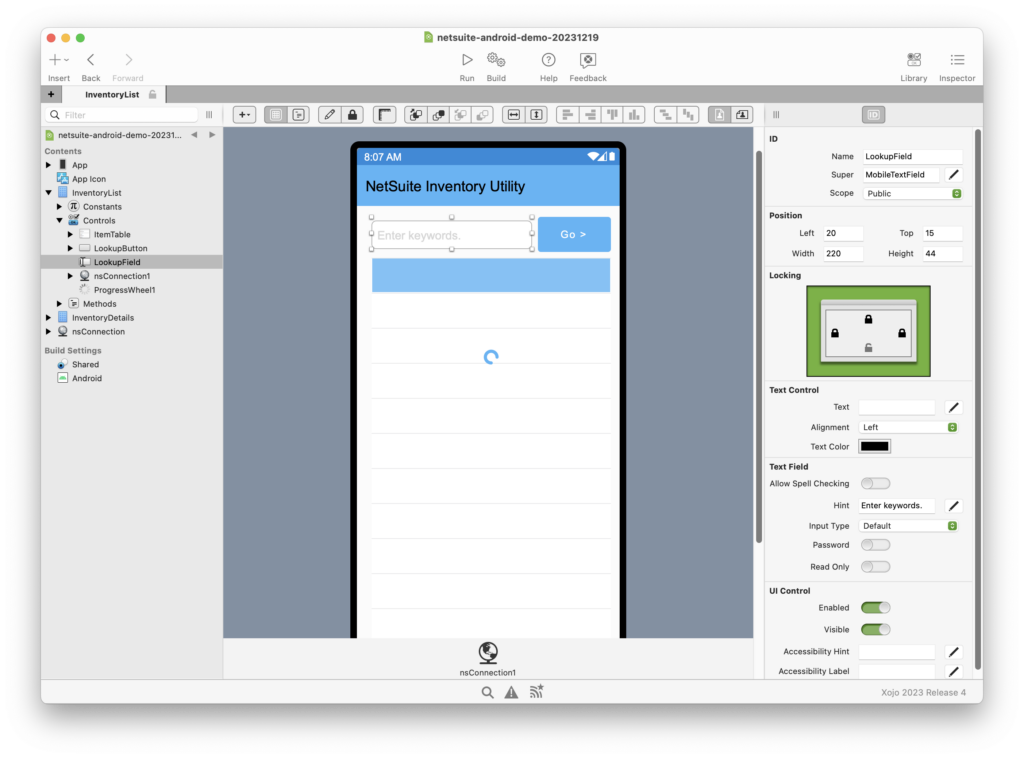Last week I was thrilled to present Xojo’s “Using Xojo to Develop NetSuite Android Apps” webinar (watch the webinar). I want to thank everyone who attended, as well as Geoff and the entire Xojo team for the opportunity. It’s always nice to be able to introduce new developers to the Xojo platform.
This blog post is intended as a follow-up to that webinar. In it, I hope to provide some additional information that we didn’t have time to cover, answer some of the questions that came up during and after the webinar, and also provide a link to the Xojo project that we created during the webinar.
Downloading the Xojo Project
The Xojo project that we developed during the webinar is available for download here. In the zip file, you’ll find the project and a “Readme” file that includes instructions on how to set things up (including SuiteTalk REST, a custom NetSuite role, an integration record, etc).

My advice is to download the project, setup NetSuite, and run the project. Then look at how the project was built -the screens, methods, and so on. After you’re familiar with the project file, experiment with it. Perhaps try modifying the project so that instead of providing access to Items it provides access to Employees instead.
If you run into any problems, or have questions, please feel free to email me (timdietrich@me.com). Another great resource for your general Xojo questions is the Xojo Programming Forum.
Have fun!
Questions & Answers
Do you prefer to use RESTlets instead of SuiteTalk REST? If so, why?
Yes, I much prefer using RESTlets in all of my NetSuite integration projects. With RESTlets I have more control over the functionality that the API provides, and more control over how the responses are formatted. Also, my experience has been that RESTlets are slightly faster than SuiteTalk REST.
That being said, SuiteTalk REST does have some advantages over RESTlets. For example, SuiteTalk REST provides endpoints that you can use to get metadata, which is something that is often difficult to do with a RESTlet. But perhaps the biggest advantage of SuiteTalk REST is that, unlike RESTlets, there is nothing extra that needs to be installed in your NetSuite account. It’s simply a matter of enabling it.
You mentioned some NetSuite customer statistics in your presentation. Can you repeat those?
Sure. During his SuiteWorld keynote presentation this year, Gary Wiessinger (SVP of NetSuite Application Development) mentioned NetSuite’s growth in terms of the number of customers that are using NetSuite. So as of October 2023, 37,000 customers are using NetSuite, and that represents 324,000 organizations. And those customers are located in 219 countries and territories.
As a Xojo developer, how can I get started with NetSuite?
You should first try to get access to a NetSuite account that you can experiment with. Unfortunately, that’s not as easy as it is with other platforms (such as Salesforce or ServiceNow), where they provide developers with test accounts. My advice would be to reach out to a local NetSuite partner, and see if you can build a relationship with them, and try to get their help in getting started.
After the demo, you mentioned another Xojo project that extends the Android functionality. What was that?
It’s called Android Design Extensions, and there’s a great blog post about it here. Read multiple posts about Android Design Extensions on the Xojo Blog.
Wrapping Up
Thanks again for your interest in Xojo and in using it to develop apps that integrate with NetSuite. I hope you’ve found the webinar and the Xojo project to be helpful.
Happy holidays!
Tim Dietrich develops custom software for businesses that are running on NetSuite. He makes extensive use of Xojo to develop mobile, desktop, Web apps, and more – all of which integrate seamlessly with NetSuite. To learn more, visit: https://timdietrich.me
